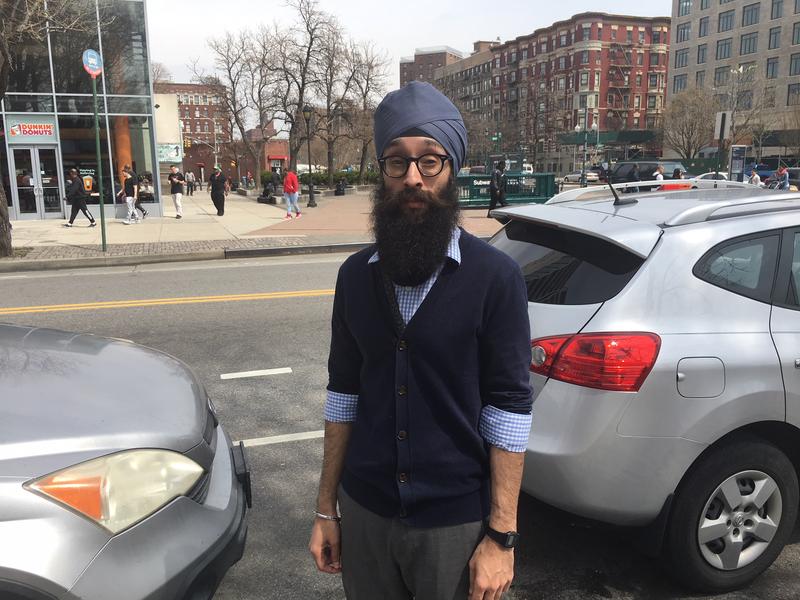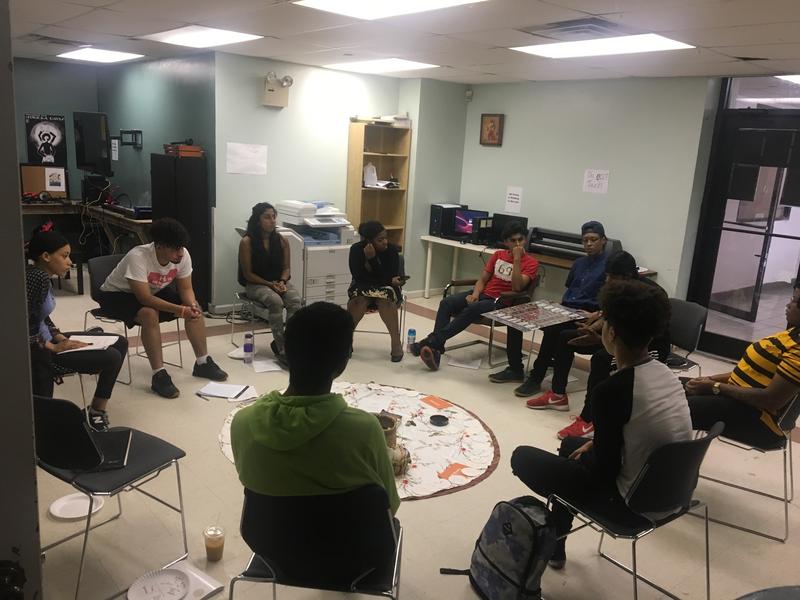
This article is part of a series, which includes this piece about attacks against Orthodox Jews in Crown Heights, as well as a discussion on the Brian Lehrer Show about solutions for dealing with hate.
One evening several years ago, Dr. Prabhjot Singh took a stroll with his younger brother. The two men were walking through Harlem, along the northern edge of Central Park, when they spotted a group of young men on bikes, 20 to 30 in all.
The street was well-lit. Singh didn't think twice about the kids until one of them rode right past him and yanked his beard.
"And I heard something about 'Osama.'"
Singh is a member of the Sikh faith and wears a turban. He and his brother ran toward a Dunkin' Donuts across the street but found themselves surrounded.
"I was punched in the face a number of times," he recalled. "My brother recalls a bike frame was used to beat my body from the back."
Singh suffered bruises and a fractured jaw. That night, at the hospital, he met another victim of his attackers, a Somali woman who had recently moved to the U.S. with her husband. By Singh's account, the young men had filled a bottle with urine and hurled it at her face, cutting her nose open.
The attack took place in 2013. One man, Christian Morales, was charged with 2nd degree aggravated harassment as a hate crime and later sentenced to a year in jail, according to the Manhattan District Attorney's office.
But Singh distanced himself from the proceedings, to the chagrin of some other Sikhs. Just a year earlier, he'd co-authored an op-ed in The New York Times, calling on the FBI to track anti-Sikh incidents of hate. However, in his own instance, he struggled to find a meaningful way of confronting what had happened to him.
The reason: His attackers came from communities of color. In other words, these were not young, privileged white men. The question he turned over in his head was, would the world be any better if they were imprisoned?
Today, Singh is Director of the Arnhold Institute for Global Health at Mount Sinai and author of Dying and Living in the Neighborhood: A Street-Level View of America’s Healthcare Promise. And he's been revisiting the night of his Harlem assault.
In recent months, a spate of incidents have taken place across the five boroughs: an attack on a subway commuter that left her with a broken spine, because she was thought to be a lesbian; an identifiably Jewish man in Crown Heights, punched in the chest by a man who just walks away. Swastikas scrawled by 12-year-olds on a school playground, along with the phrase "No Jews Allowed."
As with Singh's attack, the alleged perpetrators of these incidents were people of color. These aren't isolated examples. We know all too well that communities of color and other marginalized groups are on the receiving end of hate. But people of color commit hate crimes, too. This is born out by FBI data, year after year. In 2017, for example, 21 percent of hate crime offenders were black, although they make up 13 percent of the population.
This phenomenon, said Mark Potok, who spent twenty years at the Southern Poverty Law Center, is "the dirty little secret of hate."
He cautioned that the statistics are weak, and that white victims are "far more likely to complain" than black victims, and more likely to be taken seriously by law enforcement.
Nonetheless, "black people have their biases," said Potok, "just as white people and Latinos do."
Often, discussion of these incidents is layered with racism.
In November, two Latino teens were arrested following a violent attack on a young Orthodox Jewish man in Forest Hills. Afterward, Nora Gomez-Strauss saw the response from neighbors on a local listserv descend into name-calling.
"They started referencing them as 'animals,'" said Gomez-Strauss. "And saying 'these animals coming from other neighborhoods to our place.' And it was a pretty coded or un-coded way to say that these were kids of color coming in and doing this."
The question is, what do we do differently when people of color are accused of hateful acts? For some, the answer is nothing.
"The color of the skin, the religion, the ethnic background of the alleged perpetrator should have nothing to do with how the authorities and how the neighbors respond to a hate crime," said Rabbi Abraham Cooper, who deals with global anti-Semitism for the Simon Wiesenthal Center in Los Angeles.
"If you commit a crime, you have to be held accountable by society. And part of that usually means you're gonna do jail time."
But this thinking is exactly what Singh has resisted since the night of his brutal assault. He thinks the criminal justice system isn't the answer, because it disproportionately harms communities of color.
In the days following his attack, he had an encounter in Harlem that left him shaken.
"A young man on a bike stopped me and said, 'Are you that guy, that professor guy?' and I said yeah."
Singh said the young man responded: 'Well, fuck you, man." He also told Singh he was sorry about the attack, but that it meant he was now a target of police.
"He's like, 'Do you know that if you're a young black man that has a bike, we're being pulled into vans, for questioning about whether we attacked you? It sucks that this happened to you. But it sucks that this happens, too.'"
Increasingly, what people like Singh want is restorative justice.
RJ, as it's often called, "has become a catchall term which may describe a theory of justice, particular practices or outcomes, the mobilization of restorative practices in a particular place, or a social movement seeking to transform the way society conceives of justice," wrote Shailly Agnihotri and Cassie Veach in the City University School of Law Review. "While mediation seeks to resolve conflicts, RJ seeks a deeper engagement with the philosophical underpinnings of conflict— humans’ lack of empathy and understanding of another’s point of view."
Restorative justice plays out in countless ways, but at its heart it involves the community in ways that criminal justice rarely does. Proponents say it allows survivors of violence the chance to opt for dialogue with the perpetrator or 'responsible party' as an alternative to incarceration.
Kay Pranis, a national leader of restorative justice, said it's made significant headway in schools as a means of addressing conflict.
"When the school-to-prison pipeline movement started to have some success, they needed to have an answer: What do you do instead? You can’t just be opposed to something."
Pranis said restorative justice is a sensible response to hate crimes, "because it's about being in a respectful space with one another."
"You need to change the story that the person is telling themself, about that other person," said Pranis. "You don't change it intellectually, you change it through an interactive, human experience that allows human emotions to be present."
Although it is not specifically intended for communities of color, restorative justice has resonated there because it is seen as a corrective to criminal justice, one that also allows for healing and rehabilitation.
Still, there's little data on how effective restorative justice is, or whether it is an appropriate path for dealing with hate crimes.
But it's the choice Singh didn't have in 2013. He hopes to see more of these paths in the years ahead, regardless of who is committing the wrong.
"It's very, very important for a just and merciful society to build restorative paths for when things go wrong," he said. "And I think it's really tough when you don't see those options."
WNYC is part of the Documenting Hate project, which gathers and verifies reports of hate crimes and bias incidents. You can learn more and report incidents here. Authorities also urge those who see hate crimes to contact the police.
Correction 4/11/19, 1 p.m.: Originally, this article noted, incorrectly, that Singh's jaw was wired shut for six weeks after it was fractured. In reality, he had a stabilizing plate put in for that amount of time.


